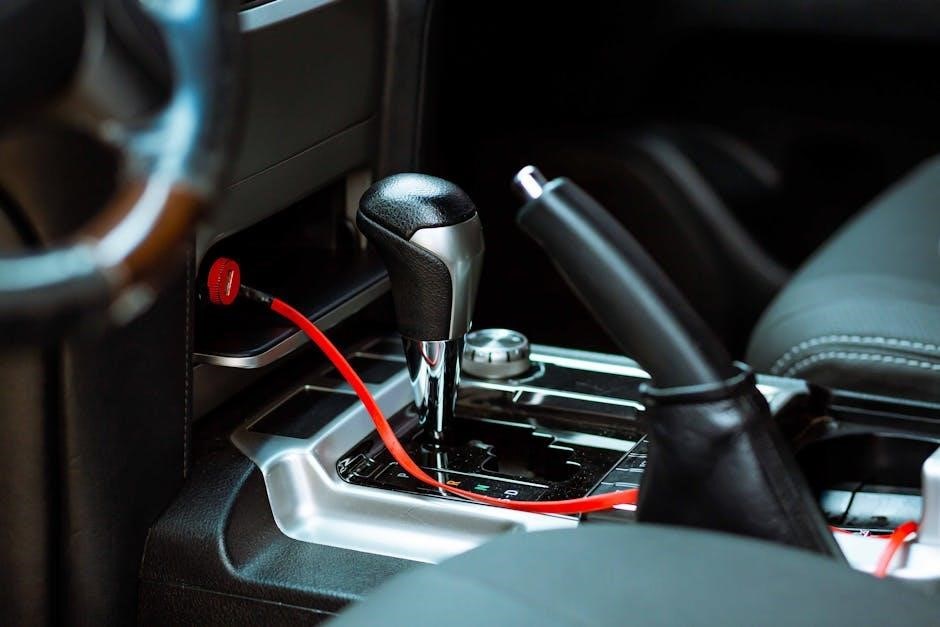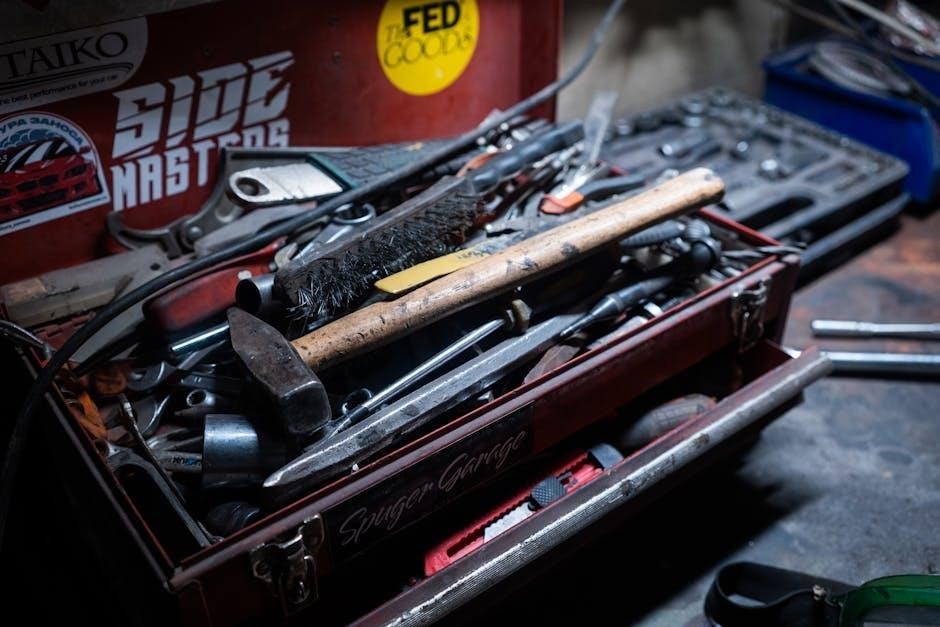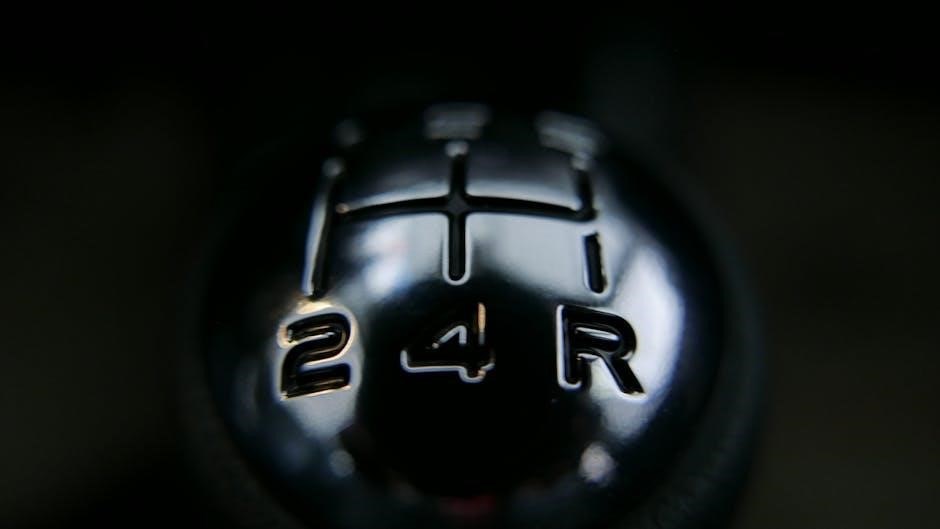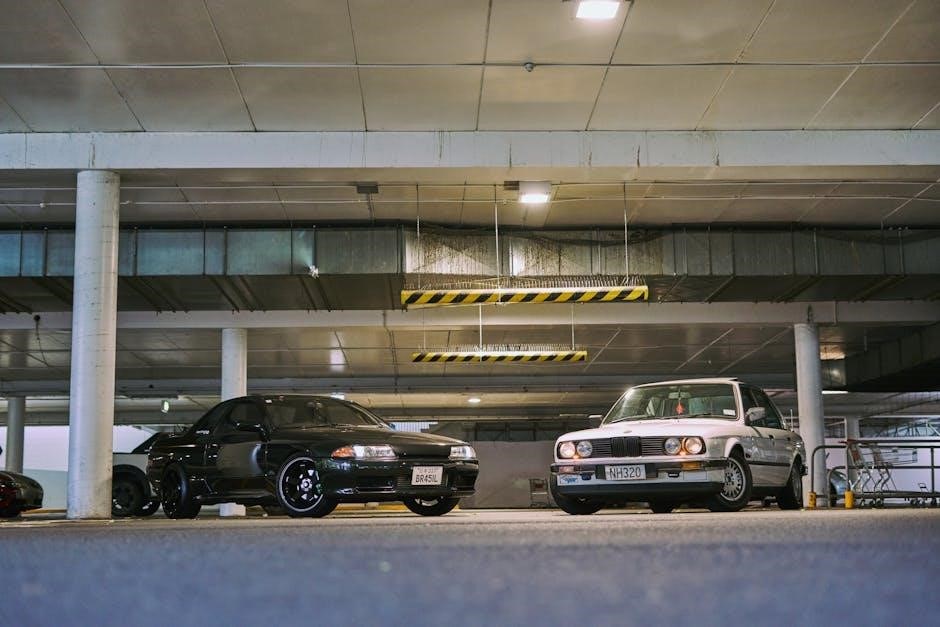Manual transmission car starters enable remote engine activation, offering convenience for drivers. They require specific installation and safety measures to function safely with clutch systems and neutral gear verification.
1.1 What is a Car Starter for Manual Transmission?
A car starter for manual transmission is a system enabling remote engine activation. It requires bypassing the clutch safety switch and ensuring the vehicle is in neutral. Designed for convenience, these systems use a remote control to start the engine, often incorporating advanced sensors to ensure safe operation. They are specifically tailored to address the unique challenges of manual vehicles, providing a seamless remote-start experience without compromising safety.
1.2 Importance of Remote Starters for Manual Vehicles
Remote starters for manual vehicles offer enhanced convenience and comfort, allowing drivers to start their car from a distance. They are especially useful in extreme weather conditions, providing a hassle-free way to warm up or cool down the vehicle. These systems also ensure safety by requiring the car to be in neutral and addressing clutch-related challenges, making them a valuable upgrade for manual transmission enthusiasts.
Compatibility of Remote Starters with Manual Transmissions
Remote starters can work with manual transmissions if specific conditions are met, such as bypassing the clutch interlock and ensuring the vehicle is in neutral gear for safe operation.
2.1 Can Remote Starters Work with Manual Transmissions?
Yes, remote starters can work with manual transmissions, but they require specific adjustments. The clutch interlock must be bypassed, and the vehicle must be confirmed in neutral gear to ensure safe operation. These systems are designed to prevent accidental starts and ensure proper engagement. However, not all remote starters are compatible with manual transmissions, so selecting the right system is crucial for functionality and safety.
2.2 Role of the Clutch in Remote Starting
The clutch plays a critical role in remote starting for manual transmissions. Normally, the clutch must be pressed to start the engine, engaging the clutch safety switch. For remote starters, this switch must be bypassed or integrated into the system to allow starting without physical clutch engagement. This ensures the vehicle remains stationary and safe during remote activation, preventing accidental movement and maintaining proper functionality of the manual transmission system.

Safety Considerations for Remote Starters in Manual Cars
Bypassing the clutch safety switch and ensuring the vehicle is in neutral are critical safety measures. Remote starters must prevent accidental movement, ensuring the car remains stationary during activation.
3.1 Bypassing the Clutch Safety Switch
Bypassing the clutch safety switch is necessary for remote starting in manual vehicles. This switch prevents engine start unless the clutch is pressed, ensuring safety. Bypassing involves wiring modifications to simulate clutch engagement, allowing remote activation. However, modern systems often use sensors to monitor clutch position, eliminating the need for full bypass and maintaining safety protocols. Proper installation is critical to avoid unintended engine starts or vehicle movement.
3.2 Ensuring the Vehicle is in Neutral
Ensuring the vehicle is in neutral is critical for safe remote starting. Modern remote starters often use neutral safety switches or sensors to verify gear position. If the transmission is not in neutral, the system prevents engine start to avoid unintended movement. Proper installation involves wiring these sensors correctly and testing to ensure the vehicle only starts in neutral gear, enhancing overall safety and preventing potential accidents.

Installation Requirements for Manual Transmission Remote Starters
Installation requires bypassing the clutch interlock and ensuring neutral gear verification. Proper wiring and sensor integration are essential for safe and reliable remote starting functionality.
4.1 Pre-Installation Checks
Before installing a remote starter in a manual transmission vehicle, ensure the car’s clutch safety switch is bypassed and the transmission is confirmed in neutral. Verify the system’s compatibility with your vehicle’s make and model. Check the wiring diagram and ensure all components, including sensors and relays, are correctly identified. Proper preparation ensures a smooth and safe installation process.
4.2 Key Components for Safe Installation
Key components include a clutch bypass module to override the clutch safety switch and a neutral safety switch to ensure the vehicle is in neutral. Advanced sensors, like Compustar’s DAS-II, monitor transmission status. A reliable two-way alarm system and high-quality wiring harness are essential. These components ensure safe and proper functionality of the remote starter in manual transmission vehicles, preventing accidental starts and potential damage.

How to Use a Remote Starter in a Manual Vehicle
Using a remote starter in a manual vehicle involves verifying the car is in neutral, bypassing the clutch safety switch, and activating the system safely for engine start.
5.1 Step-by-Step Activation Process
Ensure the vehicle is in neutral gear. 2. Bypass the clutch interlock system if necessary. 3. Press the remote start button to activate. 4. Allow the system to start the engine. 5. Confirm activation via dashboard lights or sounds. 6. Insert the key and press the clutch to disengage remote start before driving.
5.2 Demonstration with Popular Systems (e.g., Viper, Compustar)
Viper systems require pressing the remote start button twice to activate, while ensuring the vehicle is in neutral. Compustar’s DAS-II sensor monitors the clutch and neutral gear, enabling safe starts. Both systems confirm activation through dashboard lights or sounds. Professional installation ensures compatibility and proper function, providing a seamless and secure remote starting experience for manual transmission vehicles;

Top Remote Starter Brands for Manual Transmissions
Top remote starter brands like Compustar, featuring their innovative DAS-II sensor, and Excalibur’s 70 Series, offer advanced solutions for manual transmissions, ensuring safety and compatibility.
6.1 Compustar and Its Innovative DAS-II Sensor
Compustar stands out with its cutting-edge DAS-II sensor, specifically designed for manual transmissions. This advanced sensor ensures safe remote starting by monitoring the clutch and neutral gear positions, preventing accidental starts. Its innovative technology bypasses the clutch safety switch while maintaining vehicle security. Trusted by professionals and DIY installers alike, Compustar’s DAS-II sensor is a game-changer for manual transmission owners seeking reliable remote start solutions.
6.2 Excalibur 70 Series Remote Start System
The Excalibur 70 Series offers a reliable remote start solution for manual transmissions. It features advanced safety protocols, ensuring the vehicle is in neutral before ignition. Designed with user-friendly controls, this system integrates seamlessly with manual vehicles, providing cold-weather convenience without compromising safety. Its robust engineering and compatibility make it a top choice for drivers seeking a hassle-free remote start experience in their manual cars.
DIY vs. Professional Installation
DIY installation can save costs but requires technical expertise, while professional installation ensures safety and reliability. Choose based on your comfort with complex automotive systems.
7.1 Pros and Cons of DIY Installation
DIY installation of a remote starter in a manual vehicle can save money but demands technical skills. It risks damaging the clutch or safety systems if done improperly. Success requires bypassing the clutch interlock and ensuring neutral gear engagement. While cost-effective, it may void warranties or lead to safety hazards without proper knowledge. Professional guidance is often recommended to avoid critical errors.
7.2 Benefits of Professional Installation
Professional installation ensures a remote starter is safely and correctly integrated with your manual vehicle. Experts handle complex wiring, bypassing the clutch safety switch, and verifying neutral gear engagement. They use specialized tools and follow manufacturer guidelines to avoid system damage. This guarantees reliable performance, reduces error risks, and often includes warranties. Professionals also provide troubleshooting support, ensuring long-term functionality and peace of mind for manual transmission owners.

Maintenance and Troubleshooting Tips
Regularly inspect wiring, sensors, and connections to prevent faults. Ensure the battery is well-maintained, and update the system as needed. Address issues like faulty sensors or wiring promptly to maintain reliable performance and safety in manual vehicles.

8.1 Common Issues with Manual Transmission Remote Starters
Common issues include clutch interlock bypassing, neutral gear verification failures, and faulty sensors. Wiring problems and incorrect installation often cause malfunctions. Users may face challenges with the vehicle not starting or false engagement. Ensuring proper installation and regular maintenance can mitigate these issues, ensuring smooth operation. Addressing these problems promptly is crucial for reliable functionality and safety in manual vehicles.
8.2 Best Practices for Long-Term Use
Regular system checks and updates are essential for maintaining reliability. Ensure proper installation by professionals to avoid wiring or sensor issues. Monitor the clutch interlock bypass and neutral verification processes. Keep the vehicle in a secure, stationary position during remote starts. Address any malfunctions promptly to prevent long-term damage. Consistent maintenance and adherence to manufacturer guidelines ensure optimal performance and safety of manual transmission remote starters.
Future Trends in Manual Transmission Remote Starters
Advancements in sensor technology and integration with smart systems are expected to enhance remote starters for manual transmissions, ensuring safer and more efficient operation in modern vehicles.
9.1 Advances in Technology for Manual Vehicles
Technological advancements are revolutionizing remote starters for manual vehicles. Innovations like Compustar’s DAS-II sensor enhance safety by monitoring clutch engagement and gear position, ensuring smooth starts. Additionally, integration with smartphone apps and voice assistants is becoming common, offering unparalleled convenience. These advancements not only improve functionality but also address traditional challenges associated with manual transmissions in remote start systems.
9.2 Impact of Declining Manual Transmission Popularity
The decline in manual transmission popularity is influencing the remote start market. Fewer manual vehicles mean reduced demand for specialized starters. Manufacturers like Compustar and Excalibur are adapting by innovating universal systems. However, enthusiasts still value manual transmissions, sustaining niche demand for compatible remote starters, ensuring their availability despite the shift toward automatics in the automotive industry.
Remote starters offer convenience for manual transmission drivers, with brands like Compustar providing safe solutions. Proper installation and safety measures ensure reliability and performance for manual vehicles.
10.1 Final Thoughts on Remote Starters for Manual Cars
Remote starters for manual cars are a practical solution, offering convenience without compromising safety. Compatibility with manual transmissions requires careful installation and bypassing the clutch interlock. Ensuring the vehicle is in neutral and using systems like Compustar or Excalibur ensures reliable operation. While manual transmissions are less common, remote starters remain a viable option for enthusiasts, enhancing comfort and driving experience with proper setup and maintenance.
10.2 Recommendations for Manual Transmission Owners
For manual transmission owners, choosing a reputable remote starter brand like Compustar or Excalibur is crucial. Opt for professional installation to ensure safety and proper functionality. Regularly maintain the system and always confirm the vehicle is in neutral before starting remotely. Test the system post-installation to ensure smooth operation. While manual transmissions are less common, investing in a quality remote starter can enhance your driving experience and convenience, even as their popularity declines.
